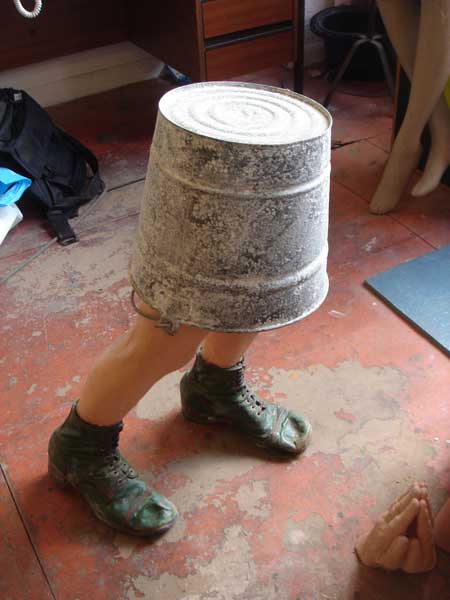Great Works: Head in the Clouds, 1974 (38in x 26in), Richard Niman
Riflemaker, London

At first glance, there seems to be very little to be said about this sculpture. If it is a sculpture at all. And what else could it be, given that it is an object in three dimensions which, until relatively recently, was evidently occupying a certain space within a West End space called Riflemaker? It looks as if it does not deserve to be talked about. It exists without the attendant benefits of cultural references. It is not posing. It is not posturing. It is not plinthing. It is what it is, crassly humorous, somewhat despicable and low-lifely in its uncouthness, something that got here, on to this high-toned page, by default.
We know even as we look at it, perhaps grimly or quizzically smiling, that it will never knock on our door accompanied by a leaden book of exegesis written by some scholar – unless this is the perilous beginnings of that hopeless enterprise. It puts us in mind, most of all, of some of the great humorists who have kept us sane and healthy down the centuries: Jonathan Swift, Laurence Sterne, Spike Milligan, John Cleese, Samuel Beckett, Steptoe and Son, Tony Hancock. It is wayward and ridiculous rather in the way that all these men – yes, they were all of that same despised gender – were ridiculous. It pokes fun. At itself. At the onlooker. But rather nastily. It is despicably small, dwarfish, although we do hesitate before pronouncing these to be the legs of a child.
Yes, are these really a child's legs? Perhaps not. They look a little too tense, edging towards muscularity, as if they may have been involved in some hard manual work, and now they are lurching – yes, isn't that more of a lurch than a slither? – home after a refreshing pint or two, bucket on head, like a first-class nincompoop. But are these not the battered black boots of a child? Well, they could be – of a rather old-fashioned kind. The 1950s, say. They can even claim some kinship with that crude representation of the child polio victim that used to stand outside chemist's shops, patiently, begging for coins. Or they could be the battered black boots of a workman, which would link these boots to the bucket. Boots and bucket – the working man's paraphernalia, head to toe.
Child or not, this rather heartlessly unnerving image does seem to cut humanity down to size – just as the dimensions of the piece itself are cut down to size – and in ways we find it quite difficult to admire. Why is it here on this page at all then? Because, it seems, in all its harsh and rather self-mocking crudity, to be telling great truths about the pitiful nature of the human condition. There are legs for perambulation – and then there is this bucket. That is just about as much as needs to be said. There is walking between here and there, and then there is the bucket work: chucking stuff in, pouring it out. Mechanical. Grindingly so. We walk, haltingly, benightedly, through this life, spectacles of pity and mockery, always less than some of us perhaps believe ourselves to be.
This bucket is rather shocking. It is filthy for a start – as it should be, of course. Buckets are habitually filthy because they are culturally despised objects, left out in the rain or the yard to rust for days at a time. They deserve no better. We have never seen an ornamented bucket, have we? A bucket is not a vase – nor is it a Greek amphora. Is it less of an amphora than a vase – even though an amphora was a useful thing too? Yes, a bucket is a working-class item, fit to be kicked across the floor, not likely to darken the doors of a museum, unless it can be pressed into service as a door stop. What of these legs though? What of legs in such uncomfortably close conjunction with a despised bucket? What can this mean? Well, it means benightedness, doesn't it? It means darkness within because there is no possibility of light inside that bucket, so no wonder the legs are staggery/faltering ahead. They are doing so because they can't see their way ahead. As we can observe for ourselves, there is no space for a body beneath this bucket, and so there is no head, and therefore no reflection upon the human condition or, more especially, upon this particular condition of benightedness. And then, of course, there is the question of the height of this creature, the fact that it has been reduced to these miserable dimensions, and that there is humiliation in the sight of those boots, the way the toes have been trodden down, so unceremoniously, those boots, too big for a child, too small for a man or a clown, such battered, in-between shoes... The entire strange concoction seems so unconvincingly assembled, so badly edited, so much like the mornings after the many nights before, oh God.
ABOUT THE ARTIST
Richard Niman, who was born in Middlesbrough in 1932, is generally regarded, alongside Conroy Maddox and Eileen Agar, as one of the original English surrealists. 'I frequently work with dolls, mannequins, shop window installations and other readymades, ' he says about his practice. 'I regard such objects in their original state as aesthetically dead. My function is to make the incredible believable.' His work is in the collection of the Imperial War Museum.
Join our commenting forum
Join thought-provoking conversations, follow other Independent readers and see their replies
Comments